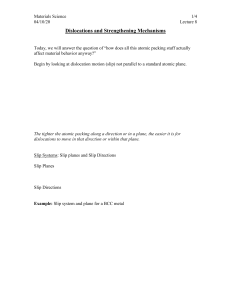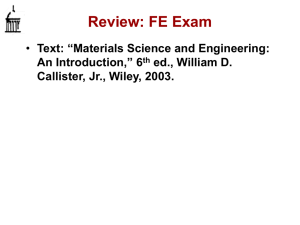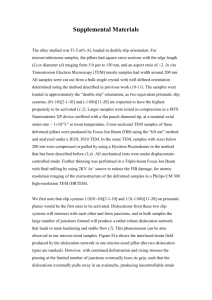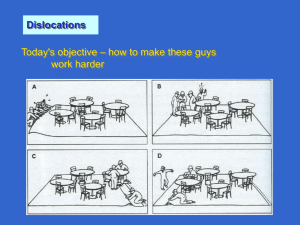Dislocation Motion Plastic Deformation in Crystalline Materials Kamyar Davoudi Lecture 8
advertisement
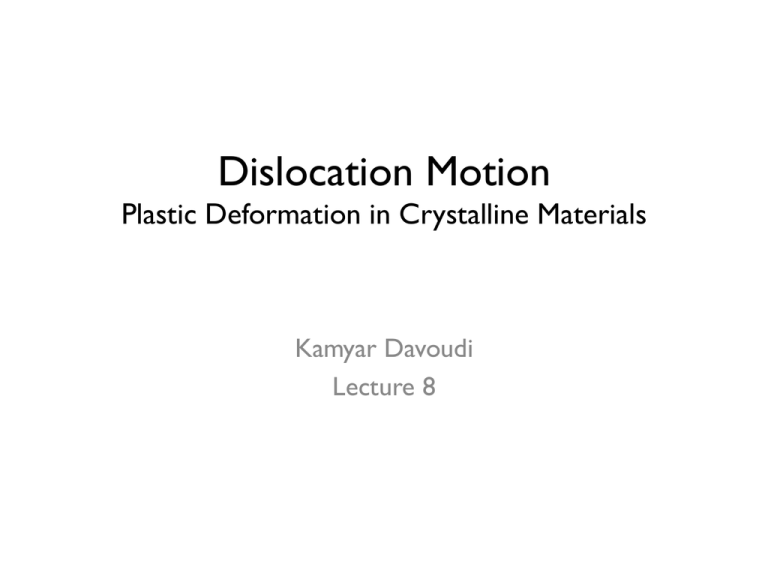
Dislocation Motion
Plastic Deformation in Crystalline Materials
Kamyar Davoudi
Lecture 8
Slip and Climb
• Dislocations can either slip (or glide) or climb
Dislocation Glide (Slip)
Dislocation climb
[Askland & Fulay, Essentials of materials science and engineering]
Slip Plane
• Slip plane is a plane that contains both the Burgers vector
and dislocation line
• Glide= motion in the slip plane
• Climb = motion out of the slip plane
• A screw dislocation can slip on any plane!
Slip System
• The slip planes and slip directions are specific
crystallographic planes and directions.
• The slip planes are normally the crystallographic
planes which have the highest density of atoms.
• the direction of slip = shortest lattice translation
vectors in the slip plane, often the direction in
which the atoms are most closely spaced.
• Slip system = slip plane +slip direction
Slip System - II
• Shortest lattice vector:
bcc: <111>/2
fcc: <110>/2
hcp: 1 1120
3
• Slip plane:
bcc: not well defined
fcc: {111}
hcp: (0001)
• In bcc, microscopic evidence: {112} and {110} ({110} is
preferred at low temperaute}
• An fcc has twelve {111}<110> slip systems.
Slip Systems - III
Argon,A.,StrengtheningMechanisminCrystalPlas3city,OxfordUniversityPress,2008.
Remarks
• Because interstitials have very high formation energy and low
migration energy, their concentration is much lower than vacancy
concentration (unless there are excess interstitials due to
irradiation). This means climb usually takes place via vacancy
absorption and emission.
• Glide is a conservative motion (does not change volume), but climb
is not because climb requires vacancy emission or absorptions.
(exceptions)
• Because screw dislocation can slip on any plane containing its unit
direction, it technically cannot climb. That is climb is defined only for
edge and mixed dislocations. (exception)
• Because climb requires diffusion, it occurs only when the
temperature is higher than 0.3 Tm where Tm is the melting point or
where is stresses are very high. Therefore except for special cases,
glide is the dominant mechanism of motion.
Conservative Climb
[Hull & Bacon, Introduction to Dislocations, 5th ed., Elsevier, 2011]
• If the prismatic loop is transferred in its plane, i.e. it does not
expand or shrink at the temperature is too low for bulk
diffusion, climb dislocation produced as a result of this
mechanism can conservatively climb.
Jogs
• It looks like that dislocation climb occurs by removing or adding
a complete row of atoms. But in practice, climb takes place by
formation of jogs.
• Individual vacancies or small cluster of them diffuse to or away
the dislocation line and form two small steps, called jogs.
• Jogs are sources and sinks for vacancies.
• Jogs do not impede dislocation glide .
[figure from Hull & Bacon, Introduction to Dislocations, 5th ed., Elsevier, 2011]
Kinks
• Steps which displace on the same slip plane are called kinks.
• Kinks do not leave the original glide.
• Not only does kinks impede dislocation glide, in fact they
facilitate glide.
Kinks
Jogs
[figure from Hull & Bacon, Introduction to Dislocations, 5th ed., Elsevier, 2011]
Plastic Deformation due to
Dislocation Motion
Orowan vs Taylor
• Orowan: If there are more dislocations, the solid
will be softer
• Taylor: If there are more dislocations, the solid
will be harder
• Which one is correct?
• Both are correct!
Orowan’s equation - I
macroscopic shear strain
D
(p)
=
h
[figure from Hull & Bacon, Introduction to Dislocations, 5th ed., Elsevier, 2011]
D=
N
X
i=1
(p)
b
b
xi = N x
d
d
A
= ⇢b x = b
V
where
x=
N
X
i=1
where
⇢ = N/V
δA is the total area swept by all dislocations
xi
!
/N
Orowan’s equation - II
˙
(p)
⌘
d
(p)
dt
d⇢
dx̄
= b x̄ + b⇢
dt
dt
Except under extreme conditions where dislocations move very
quickly, it is reasonable to neglect the first term on the right hand
side of the above, to arrive at what is called Orowan's equation:
˙ (p) = ⇢bv̄
where v is the average velocity of dislocations.
Because
⇢v̄ = ⇢m v̄m
where subscript m refers to mobile dislocations, Orowan’s equation
is often written as:
˙ (p) = ⇢m bv̄m
Orowan’s equation: Micormechanics Approach
• the plastic strain due to an edge dislocation is given by ε xy* = b δ ( y ) H (−x )
2
b
2
• for a dipole of a distance d: ε xy* = δ ( y )$% H (−x ) − H (−x + d )&'
• If one of them travels by Δx
b
b
b
*
Δε xy
= δ ( y ) H (−x − Δx ) − δ ( y ) H (−x ) = δ ( y ) %& H (−x − Δx ) − H (−x )'(
2
2
2
• The above formula is the change in the local plastic strain. The average
plastic strain can is given by
1
*( LOC )
*
Δε xy =
V
∫ Δε
xy
dV
V
• If we consider a body of thickness t, we will have
Δε xy* =
t
tA
∫
A
b
b t
1 bΔx
δ ( y ) &' H (−x − Δx ) − H (−x )() dydx =
1×
Δx
×1
=
(
) 2 A
2
2 tA
• It can also be written as
Δε xy* =
bδ A
2V
where δA is the area swept by the dislocations.
Shear - I
• Changing coordination system:
where
y’
y
( p)
( p)
ε ij( p) = aiα a jβεαβ
= aix$ a jy$ε x( $p)
+
a
a
ε
y$
iy$ jx$ y$x$
x
n b
aix! = iˆ • x̂! = iˆ • b̂0 = bi0
a jy! = ĵ i ŷ! = ĵ i n̂ = n0j
( p)
x’
(
0
)
0
( p)
with b0=b/|b|, and so on. Thus ε ij = bi n j + bj ni ε x"y"
• In general, the average strain Δε ij( p) produced by an increase δA in the
slipped area is:
Δε
where b=|b| and.
( p)
ij
b δA 0
δA
0
=
bi n j + bj ni =
bi n j + bj ni
2V
2V
(
)
(
)
Shear - II
•
α ij
(
=
bi0 n j + b0j ni
2
) is called the Schmid strain
resolution tensor
• If the shear is produced by a set of m separate
slip systems, then
Δε ij( p) = ∑ bm
m
α ij( m)δ Am
V
Shear - III
• The plastic distortion β(p) is caused by the
slip bi , can be written as:
! !
* !
β ji( r ) = −bi n jδ(S − r )
where δ(S-r) is the 1-dimensional Dirac delta
function in the normal direction of S. δ(S-r) is
infinite when r is on S and zero everywhere
else.
• And
! !
!
1
ε ( r ) = − (bi n j + b j ni )δ(S − r )
2
*
ij
S=Ω
Orowan’s Equation when Dislocations Climb
• When edge dislocations climb, the volume of the crystal changes, and the
sample experiences (normal) plastic strain
"(p) = D/d
With the same method that we used for glide, we can show that the normal
plastic strain is
"(p) = ⇢bȳ
where ȳ is the average climb
distance.
• If changes in dislocation density
are negligible
"˙(p) = ⇢bȳ˙ = ⇢bv̄
Orowan’s view
• Based on Orowan’s equation, higher
dislocation density means larger plastic strains
and consequently a softer material!
Further Reading
(1) Argon, A., Strengthening Mechanism in Crystal
Plasticity, Oxford University Press, 2008.
(2) Hull, Bacon, Introduction to Dislocations, 5th ed.,
Butterworth, 2011.
(3) Mura, T., Micromechanics of Defects in Solids,
Kluwer Academic Publishers, 1987.
